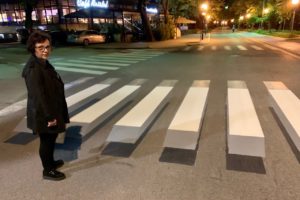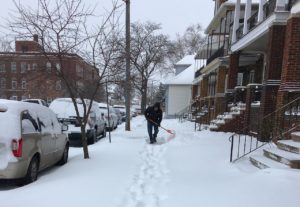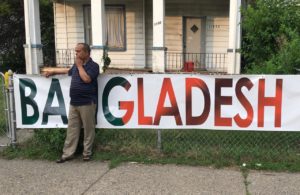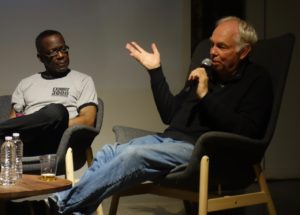2019: A year of big ideas and new challenges
By Walter Wasacz
Let’s chalk up 2019 as the year City Life began to turn words into advocacy, advocacy into action.
Let’s remember it as the year we began to put Hamtramck’s future under microscopic view, challenging leadership and ourselves to help fulfill the city’s potential, making it a better place to invest, live, work, play.
Before we jump full blast into 2020, our first step forward is to review the year behind, learn from our successes — and, more importantly — from our failures, finding doable ideas and solutions that work in other places.
Where have we been, where are we now and where are we heading? Are we stagnating or on the path to growth and sustainability?
Those are some of the questions this column will be addressing over the coming months.
——–
At the beginning of 2019, we wrote about the “zigs and zags of winter walkability” — asking the question: Would you pay an extra, say, $35 a year for sidewalks to be plowed after it snows?
It’s a question being asked by northern cities taking the responsibility for making sure that commercial districts and residential neighborhoods remain walkable throughout the winter months.
Largely because of budget shortfalls many communities, Hamtramck among others, cannot afford to clear sidewalks for pedestrians.
In a story in online magazine CityLab, it was reported that Rochester, New York plows sidewalks when snow totals are four inches and above.
In the direct path of lake-effect weather that blows in from Lake Ontario, that city pays for removal through an ’embellishment fee’ on property-tax bills, averaging $35 per homestead.
The article went on to say that Duluth, Minnesota clears 100 miles of priority sidewalk routes, including routes to schools, high-pedestrian traffic locations, and public-transit locations.
Bloomington, Minnesota clears all of its 250 miles of sidewalks. The story suggests that these cities’ programs could act as templates for others to formulate a plan for safe pedestrian paths in the winter.
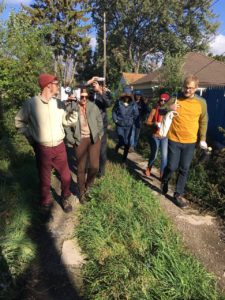
Psychogeographic stroll through green alleys along Detroit-Hamtramck border during the 2019 neighborhood arts festival.
But few do, encouraging home and business owners to take care of sidewalks in front of their properties — and ticketing and fining those that don’t.
After two snow accumulations in January 2019, each roughly 4-5 inches, the sidewalks in most neighborhoods were impassable for days.
Some people shoveled or brought out snowblowers and carved out paths in front of their properties. They surely deserve a tip of the cap from all of us.
But as I walked around the city on one of those days I found too many of the sidewalks in front of houses, vacant lots and even those directly in front of buildings on Jos. Campau, Caniff and Conant – the three main commercial arteries in the city — packed with snow and later ice after the region experienced below zero temperatures.
My walk was a series of zigs and zags from a few cleared sidewalks to cleared streets, where I had to share the road with cars and trucks – a dangerous option for any pedestrian.
But what if I were disabled, even temporarily, or more permanently handicapped? What if I needed to do my shopping using a walker or wheelchair? Or if I were a young mother pushing her baby in a stroller?
In that same CityLab article the writer, who is from Kalamazoo, said a pregnant woman was hit by a motorist after being forced to walk in the street in that west Michigan city. The sidewalk where she was supposed to walk was covered in snow.
She was just grazed, so presumably the injury was not serious.
That could happen here, on Gallagher or Brombach, on Mackay or Lumpkin, to kids walking to and from school. Being grazed when walking in the street is bad enough but chances are it could be far worse in a densely populated community like ours.
In Syracuse, New York, a yearlong pilot program was launched to plow 20 miles of “priority sidewalks” — determined by using data that showed areas of highest pedestrian usage – after each snowfall of three inches or more. The program was initiated by community activists and implemented by a city administration that listened to them and took action.
The money (approximately $170,000) came from an existing public works budget, no “embellishment fees” were needed. But to sustain a program like this, there is no doubt that new streams of money will need to be found.
So how does Hamtramck, with its limited financial resources, do something like this on sidewalks stretching across its two square miles?
Maybe it starts with Jos. Campau and becomes a project initiated by the Downtown Development Authority (DDA). That strip from Denton to Carpenter could be our pilot program, extending a message of welcome and hospitality to shoppers and other visitors.
It would make a good companion plan to the Joe Louis Greenway, the bicycle lane scheduled for construction on the length of Jos. Campau in the spring.
(An update: the Hamtramck Downtown Development Authority recently sourced an outside contractor to clear Jos. Campau sidewalks – which was done after the most recent snowstorm — an important first step to making the central business district walkable year-round.)
But the neighborhoods need to be walkable for the people who live here, too. Pedestrian activity in a place that wants to be or sell itself as one of the most walkable communities in the state cannot be seasonal. It must be year-round and 24/7.
How do we begin?
First by buying into the idea that the public streets and walkways of Hamtramck are in fact ours. Let’s not forget what ‘public’ means: it’s sharing and contributing to the geographic space in which we live, work or visit. It means all of us are in this together.
Public life is ours to shape and govern, now and later. That’s as real as it gets.
All of us are owners of the way we move and navigate through the city. If we want to walk on winter sidewalks cleared of snow and ice, we must imagine, demand and create solutions.
Will we invest in our future by paying more for a better quality of life, not only for ourselves and our families or for the sake of our own properties?
Will we put our heads together and find solutions that benefit everyone in Hamtramck, using models of success in other, also cash-strapped, cities?
Update: the 3-D crosswalks and vertical bollards were never installed. To questions about the project Angerer responded to me in November by email: “It was my hope also that we would complete this work this year. Unfortunately, with the weather and construction delay issues, it was not possible. The contractors have overbooked themselves and hop from city to city and often times don’t complete their contracts.”
She also wrote that the “busy construction season has been plagued with rain, delays, contractor issues, an early large snowfall and more. Along with all of the City projects, we have DTE tearing up all areas of our City. We are trying to get them to finish what they have started while the final days of decent weather to restore sidewalks for walkability.”
The response concluded with this follow-up from the engineering firm that works on the city’s behalf: “The 3-D crosswalks will have to be installed in the Spring. However, PK (the contractor installing the crosswalks) will place, at their expense, the typical continental crosswalks for the winter where 3-D striping is proposed and will remove and place the 3-D crosswalks in the spring as soon as weather permits.”
So, we will wait until spring to tackle this topic once again.
——–
From last summer: two stories from along the Conant corridor that explored the unique diversity of Hamtramck — and how we grapple with evolving community identity issues, now and likely into the near –future.
The first one: walking through the Bangladeshi festival – celebrating its 20th year holding this event — brought back memories.
As I walked up and down Conant, I imagined the future of this vital corridor, now the focus of an ambitious development project by the City of Detroit.
Wide-ranging plans include the rehabilitation of buildings on Conant, Dequindre and the former Transfiguration school building near Mound. American Axle is putting $5 million toward the neighborhood plan and a Bingham Farms-based housing development company is proposing the construction of a $17 million, 50-unit apartment building on the northeast corner of Carpenter and Charest.
Streetscape Improvements are planned for the Conant business district, which extends on the Detroit side of the avenue from just north of Harold to Davison. It’s unknown what Hamtramck’s contribution to the streetscape will be on the west side of Conant.
Also unknown is how the departure of influential chief City of Detroit planner Maurice Cox, who is leaving for a similar posting in Chicago, will affect the plans for Banglatown.
Cox was an advocate of the “20-minute neighborhood,” where people can walk or bike to get basic needs met within that time frame. He expanded the number of planners employed by the city from around six to 36 in five years.
It’s not accidental that redevelopment projects are underway in several Detroit neighborhoods: there is a lot of talent behind the increased activity.
Some Banglatown improvements high on the list to consider would be bike lanes, curb and crosswalk improvements and traffic calming strategies to increase pedestrian activity and safer streets. Facade enhancements to existing businesses, and business recruitment and retention should also be on the list.
It also wouldn’t hurt to create budgets for PR and marketing the region’s most concentrated Bangladeshi community. It is far too insular for a neighborhood and business district so unique. When Conant throws a weekend party everyone in metro Detroit — over 5 million people live within a 50-mile radius — should be invited, the streets packed with visitors from near and far.
Update: Earlier this month, a national jury selected by the American Institute of Architects (AIA) gave the City of Detroit’s Planning and Development Department a regional and urban design award for its Campau/Davison/Banglatown Neighborhood Framework Plan. Only four projects across the country were named. Kudos to our neighbor for a job well done. It’s exciting to see recognition for progress being made on borders Hamtramck shares with Detroit.
——-
And this one, from a soccer match at Keyworth Stadium:
The faces of the people in the crowd also made an impression on me. Young, old, middle aged, and of every color under the rainbow (which by the way, on cue made an appearance in the sky on the southern horizon as the rain still came down).
“Rainbow” is another key word in this story. The most passionate, and often crude and profane, fan supporters of Detroit City, the Northern Guard, fly a rainbow flag at all home matches.
The DCFC club takes its community of inclusion role seriously, supporting local projects for Hamtramck’s largely Muslim youth population as well as initiatives for LGBTQ youth at risk (at Highland Park’s Ruth Ellis Center).
The social and political environment established by the club is explicitly progressive: anti-racist and pro-immigrant, for gender-equality and pro-LGBTQ, sharing the same passion for sport and positive social change.
It represents an ever-changing world as it is now, in other words, a model of diversity and inclusivity that can be easily replicated across these two square miles of urban geography in which we live.
Perhaps a rainbow flag to join the national flags installed on Jos. Campau north of Caniff is the next step forward in growing the city’s progressive, tolerant profile being shaped in large part by the community mission of a football club reaching for the stars.
It should be a community mission to set even higher standards for being a city of progress, creating goals that retain the virtues of welcoming and hospitality — that means everyone under the stars included – for decades to come.
Let’s keep this conversation alive, vital and real.
——
Another story that had to do with breaking down borders and shareable human resources, from October:
Last Saturday morning, I led a group of around a dozen people on foot through streets and alleys along the Detroit-Hamtramck border.
I was asked by Banglatown-based The Hinterlands — an experimental theater, performance art and community engagement collective based in Banglatown — to participate in a mobile workshop we called a psychogeographic stroll.
I did a group walk using the same title during the Porous Borders festival, organized by The Hinterlands and other artists in Banglatown and Hamtramck, in 2015.
This one was both a physical walk and a virtual one, linked via Skype with an audio-visual production station inside the group’s Play House, where we were connected to two Russian philosophers in Moscow. It was streamed live on Facebook and Periscope.
What we did might be dubbed “techno-psychogeography,” a futuristic, early-21st century take on what began in 1950s’ Paris as a playful exploration and interaction with urban environments.
Called the “derive” (or the “drift”) by the Situationists, an art/politics movement that created no art (aside from provocative graffiti strewn across buildings in Paris during the student/worker protests in May 1968) and had no desire to govern, walks like these are the cornerstone practice of psychogeographical societies in San Francisco, New York, London, Manchester (UK) and elsewhere.
Our “renegade performance walk” was part of an all-day series of Hinterlands’ activities called “Border Blast II” as well as just one piece of the even larger Hamtramck Neighborhood Arts Festival.
We began at Play House — the performance space used by The Hinterlands, — at the corner of Moran and Lawley streets.
We walked around the corner and then south down the alley between Moran and Klinger.
There, we spotted a Mercedes with deflated tires pressed up against a wooden privacy fence. “Something happened here,” I asked, vague mystery in my voice intentional, “but what?”
Lush, green leaves were growing around it. The entire alley in fact appeared as many shades of bright green, aglow in muted sunshine slicing through the canopy of giant trees high above.
All green, that is, aside from garages covered with vivid blue or saturated mauve paint or the occasional dusty brown or gray, with only hints of the yellow and orange natural colors of fall still to come.
At Halleck, we walked left and carefully crossed fast-moving Conant Avenue to the edge of Jayne Field. This huge, once forgotten park is a centerpiece of the City of Detroit’s Campau-Davison-Banglatown redevelopment plan.
We stopped to talk and imagined ourselves at a picnic, spreading blankets across the grass and sharing food.
As we crossed Charles, I asked rhetorically if anyone had ever walked on Justine St. to Carpenter. We were here now, I answered, in the neighborhood once labeled Hamtramck Heights in the 1960s, evidenced by suburban, ranch-style housing built from the late-1950s to early-1970s.
This neighborhood was one of several gateways to Warren and other newer suburban communities, where the white majority population began its pattern of abandonment and northward migration over half a century ago.
A question about municipal corporate borders and why we even have them came from Irfan Hosic, a Fulbright scholar from Bosnia doing a year of research in Detroit. Others on the walk had similar questions, including why it was necessary to duplicate services — public education and safety, water and waste management — over politically established borders such as Detroit and Hamtramck share.
Why not pool resources for the good of the public that cities serve, rather than divide and dilute them — unequally and unjustly — I posed as another question.
On Fenelon we walked past newly-installed speed humps and witnessed their effectiveness in slowing down traffic. “Wow, they actually work,” someone said.
We crossed Conant again and into the alley east of Moran. Richard Newman from The Hinterlands, who was following along from the control desk at Play House — Newman’s colleagues Renee Willoughby and Dave Sanders were providing tech support with microphones, cameras, iPhone and iPad on the walk — asked if we were now in Hamtramck.
“Yes!” came the response as a chorus from the walkers.
“It feels different here,” Hosic said.
The alleys are paved in Hamtramck; in Detroit, across Carpenter and Conant, mostly they are left to dirt, gravel and grass, I said. A few times I’d heard Newman saying the same thing to the couple, Helen Petrovsky and Oleg Aronson, in Moscow and translator Jonathan Flately in Detroit.
But it is also a different environment, I said, regardless of what city we are in now the “feels” are different, the ambience of the place is altered just by crossing a street.
The political borders are far less relevant than are neighborhood borders, an important distinction.
We walked up the alley behind Hamtramck Disneyland, now being restored by the Hatch Art collective that purchased it from original owner Dmytro Szylak’s family after his death in 2015, then across Carpenter to Klinger (more speed humps, slowing traffic on an already narrow two-way street) and back to where we began our journey 90 minutes before.
We’d actually lost one part of the feed from Russia along the way (apparently they could see us, but we couldn’t communicate with them) but it didn’t matter at all. The group was immersed in the experience, as if surrounded by strange, beautiful music on the cusp of foreign and familiar.
——-
Finally, I wrote about conferences I helped organize and in which I participated in 2019. The topics were both global and hyper-local, with lots to be applied to Hamtramck’s present and future.
One of them took place in late September, the location was Milwaukee Junction, a Detroit neighborhood just a few blocks from the far southwest border of the city.
Last weekend I had the privilege of participating in a digital media conference in Detroit. The over-arching theme was ‘access,’ and there were dozens of panels, presentations, performances and workshops on communication, urban space, mobility and transportation, race, gender and queer politics, immigration and refugee justice, the importance of inclusivity and partnerships — concluding with a danceable afterglow at a renovated underground studio space in New Center.
I moderated a discussion on “unlocking the potential of the 24 economy” — a trend gaining steam worldwide.
The “no curfew” expert on our panel was Dimitri Hegemann, the famed Berlin entrepreneur who helped convert inspirational Detroit dance music energy into what I call “sustainable euphoria” — a positive social tool that played a major role in the German capital’s economic and cultural recovery in the 1990s after decades of war, occupation, political and institutional division.
Through a serendipitous side door entered Detroit techno, which became, in Hegemann’s words, “the soundtrack of reunification” — also called the “peaceful revolution of 1989” — bringing youth from east and west together on the dancefloor.
Those “dancefloors” that emerged soon after the fall of the Berlin Wall in 1989 were hardly glamorous places. They were usually located in dank, dark basements and abandoned industrial spaces, barely-salvageable relics from both hot and cold wars of the last century.
Social innovators like Hegemann and his peers, many of whom were active in West Berlin’s alternative rock culture of the 1970s and 1980s — which featured artists like David Bowie, Iggy Pop, My Bloody Valentine, Nick Cave and Einstürzende Neubauten — used the rubble of a collapsed society to begin creating a previously unimagined future.
One piece of that future was already in place: a 24-hour service economy that put no restriction on alcohol sales.
That came in 1949, when a U.S. military commander in charge of West Berlin’s American Sector (the city had been divided into east and west after World War II, though the Wall surrounding West Berlin was still to be built 12 years later) made a decision to allow 24-hour bar service to keep drinkers from spending late night hours in the sector controlled by the Soviet Union.
The Russians allowed drinking in bars and cafes until 1 a.m. The French and the British, which controlled the two other sectors, had even earlier closing times.
It was the Americans, Hegemann points out, that showed the initiative — albeit one born out of Cold War rivalry — to open up the night to what he calls “what is possible, always the potential to do more.”
“Potential” and “freedom to try anything and do more” are the key words and phrases of a worldwide night economy and creative industries initiative that my nonprofit group, the Detroit-Berlin Connection — which I co-founded with Hegemann in 2013 — advocated at the conference (organized by the Berlin-based digital media accelerator re:publica) and others yet to come (we talked about the influence of Detroit creativity on the modern night in Berlin and Dortmund, Germany in November 2019).
What impact can all these lofty discussions have on Hamtramck?
Plenty.
Hamtramck (viewed from afar as a vibrant, multicultural district of Detroit, rich in creative spirit and talent, more than as a separate municipal entity) is well known to our partners and friends in Berlin, Barcelona, Amsterdam and other cities with expansive night economies.
They are attracted by the scale of our commercial avenues and residential streets, easy accessibility both within its 2-square miles and to nearby neighborhoods like the North End, Milwaukee Junction and New Center (three connected areas of Detroit where all of the conference activities took place), as well as Banglatown on Hamtramck north and northeast borders.
There are food, drink and lodging options within this dense urban community — arguably its single greatest asset — and it’s walkable and reachable by bicycle day and night.
So what more can Hamtramck do to join this worldwide movement for which it already seems perfectly suited?
• First join the conversation. We can learn a lot by having dialogue with urban thought leaders, cultural disruptors and producers doing it at a high level in Berlin and elsewhere. Closer to home, build networks with Detroit planners and economic developers now reshaping connective neighborhoods literally at our doorstep.
• Begin building tangible, visible, hands-on relationships with entities — government bodies, foundations and other institutions and organizations — that have the resources to enable growth. Only strong, committed partnerships can help create pathways to Hamtramck’s future.
• Take advantage of every opportunity to make Hamtramck more attractive, safe and livable. The recent Holbrook reconstruction project could have included bike lanes to allow cyclists-protected access on east-west routes in the city. Phase two of the Holbrook road project is scheduled to begin this spring — more bike lanes should be considered there and for Lumpkin, Brombach/Mackay, Gallagher, Conant and Buffalo (north-south); and Caniff and Carpenter (east-west). Let’s all commit to putting healthy pressure on government and community leaders to not overlook what’s possible. Slower, shareable, safer streets accessible to all must be a top priority in the city’s future.
• Commit to better economic development practice, including attracting and retaining businesses that will work in a rich, diverse community like Hamtramck. We have models of success: Oloman Cafe & Gallery, Bon Bon Bon, Bank Suey, Bumbo’s, Planet Ant, Ghost Light, Al Haramain, Aladdin Sweets and Cafe, the Film Lab, Balkan House, Yemen Cafe and others that have gotten regular or recent positive media attention.
Impressive as the above list may be, it is in reality a fractured collection of organic independents than a result of any intentional planning strategy.
Also, failures: how could the city allow a major local and regional influencer like Wheelhouse Detroit to close up shop? Wheelhouse was more than about business, more about social innovation and lifestyle revolution: it was both a glimpse and a symbol of what a healthy, less-motorized transportation future could look like.
Owner Kelli Kavanaugh — a founder/organizer of successful events like Tour-de-Troit and the Paczki Run — is the kind of unique community partner that comes along too rarely and not easily replaced.
It is vision like hers — aside from the brick and mortar business itself – that can endure and still be used productively if we so desire. In City Life, we’ll follow the bouncing ball during the coming months to see if it does.
Native Hamtramckan Walter Wasacz’s column appears twice a month in The Review.
Jan. 31, 2020

